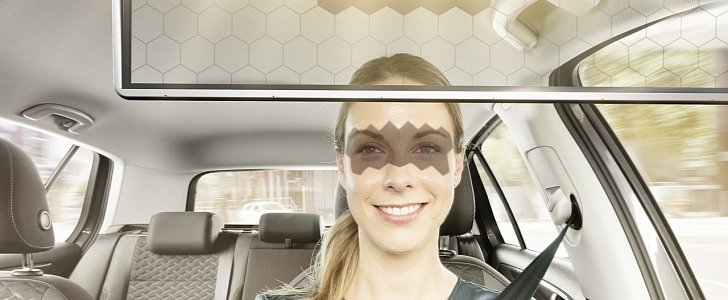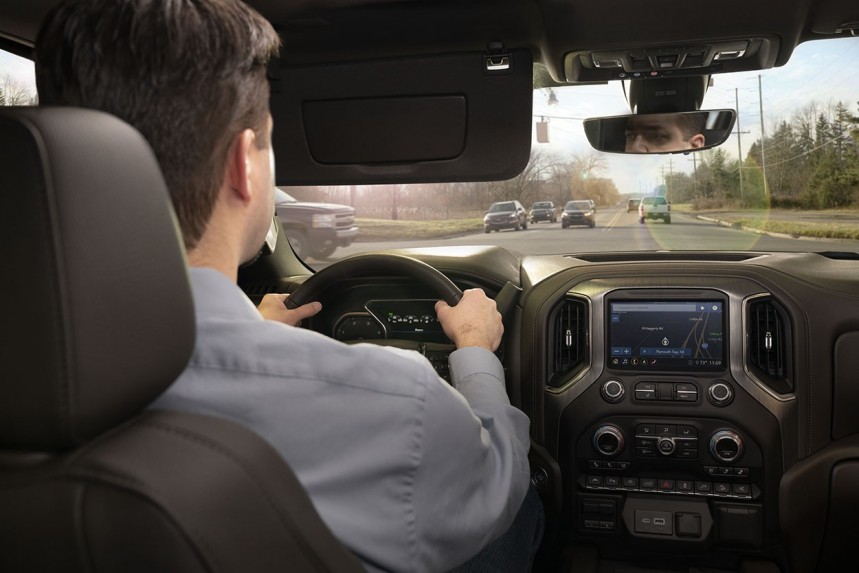With the 2020 edition of the Consumer Electronics Show underway in Las Vegas, Bosh is shining a spotlight on what it calls “one of the most overlooked interior components” of a car: the sun visor. That is, the one that was invented some 95 years ago and suffered little modification along the way.
First introduced in 1924 as a “glare shield” in a Ford Model T, the sun visor’s functionality is stated in its name: it’s meant to block out the sun, to keep it from getting in the driver’s eyes but, most of the time, it blocks a little more than just that. Bosh proposes a new take on the ol’ sun visor, reinventing it and, in the process, replacing it altogether.
This sounds like a paradox, and it’s made possible with help from artificial intelligence. By 2025, Bosch estimates each of its products will either contain AI or have been developed with help from it. The sun visor is a good place to start.
Instead of the blunt object that can be moved around by the driver whenever he feels the sun glare on his face, Bosch proposes replacing it with a transparent LCD display. The display connects with an interior camera that monitors the driver’s face, and AI tracks and analyzes the face in the image on the camera.
By analyzing the shadows cast on the face, the AI can determine which area of the transparent LCD display need darkened to keep the sun out of the driver’s eyes. This way, Bosch says, the driver will be protected against sun glare, but without the downside of having half the road obscured as well. Put it simply, the Virtual Visor will cast a shadow only on the driver’s eyes without obscuring anything in front of him at all.
Using liquid crystal technology, the Virtual Visor is effective in reducing accident risk and driver discomfort, Bosch says, while increasing comfort, safety and visibility for the driver. And it’s all possible thanks to AI, which Bosch is funneling money and effort in, because the future is AI-based.
The idea is a solid one, if you think about it. For all its merits, the traditional sun visor does block more of the road than the driver would want. Moreover, according to studies cited by Bosch, temporary blindness caused by the sun causes twice as many accidents as any other weather-related condition. Figures from the NHTSA confirm this, while another study highlights a 16 percent increase in the odds of an accident during bright sunlight, as opposed to normal weather.
If only Bosch had come out with this smart sun visor before Prince Philip, the Duke of Edinburgh, surrendered his driver’s license after the 2-vehicle crash he caused near his UK estate last January. He too, was temporarily blinded by the sun and T-boned another vehicle that had the right of way at an intersection.
“For most drivers around the world, the visor component as we know it is not enough to avoid hazardous sun glare – especially at dawn and dusk when the sun can greatly decrease drivers’ vision,” Dr. Steffen Berns, president of Bosch Car Multimedia, says of the Virtual Visor in a press release ahead of the product’s introduction at CES 2020. “Some of the simplest innovations make the greatest impact, and Virtual Visor changes the way drivers see the road.”
“We discovered early in the development that users adjust their traditional sun visors to always cast a shadow on their own eyes,” Jason Zink, technical expert for Bosch in North America and one of the co-creators of the Virtual Visor, adds. “This realization was profound in helping simplify the product concept and fuel the design of the technology.”
While the Virtual Visor was just introduced at CES, it’s already been around for long enough to sweep some industry awards, in addition to getting considerable support. For instance, it won the Best of Innovation in the In-Vehicle Entertainment & Safety category at the CES 2020 Innovation Awards, voted by a panel of judges that included engineers and techies, and designers.
This sounds like a paradox, and it’s made possible with help from artificial intelligence. By 2025, Bosch estimates each of its products will either contain AI or have been developed with help from it. The sun visor is a good place to start.
Instead of the blunt object that can be moved around by the driver whenever he feels the sun glare on his face, Bosch proposes replacing it with a transparent LCD display. The display connects with an interior camera that monitors the driver’s face, and AI tracks and analyzes the face in the image on the camera.
By analyzing the shadows cast on the face, the AI can determine which area of the transparent LCD display need darkened to keep the sun out of the driver’s eyes. This way, Bosch says, the driver will be protected against sun glare, but without the downside of having half the road obscured as well. Put it simply, the Virtual Visor will cast a shadow only on the driver’s eyes without obscuring anything in front of him at all.
The idea is a solid one, if you think about it. For all its merits, the traditional sun visor does block more of the road than the driver would want. Moreover, according to studies cited by Bosch, temporary blindness caused by the sun causes twice as many accidents as any other weather-related condition. Figures from the NHTSA confirm this, while another study highlights a 16 percent increase in the odds of an accident during bright sunlight, as opposed to normal weather.
If only Bosch had come out with this smart sun visor before Prince Philip, the Duke of Edinburgh, surrendered his driver’s license after the 2-vehicle crash he caused near his UK estate last January. He too, was temporarily blinded by the sun and T-boned another vehicle that had the right of way at an intersection.
“We discovered early in the development that users adjust their traditional sun visors to always cast a shadow on their own eyes,” Jason Zink, technical expert for Bosch in North America and one of the co-creators of the Virtual Visor, adds. “This realization was profound in helping simplify the product concept and fuel the design of the technology.”
While the Virtual Visor was just introduced at CES, it’s already been around for long enough to sweep some industry awards, in addition to getting considerable support. For instance, it won the Best of Innovation in the In-Vehicle Entertainment & Safety category at the CES 2020 Innovation Awards, voted by a panel of judges that included engineers and techies, and designers.








